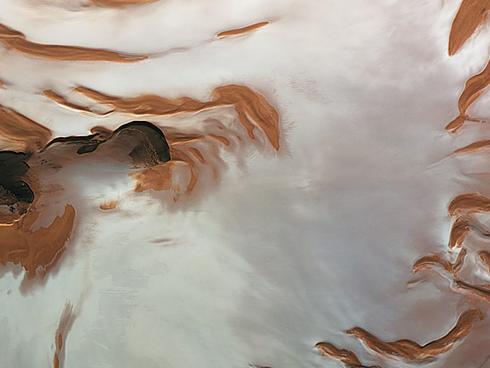The new science of the old European spacecraft orbiting Mars - continued

Makhteshim
For the first part of the review
Eberswalde Crater - is located in the southern highlands of Mars and has a diameter of 65 km. It is estimated that it was formed 3.7 billion years ago. Due to the impact of an asteroid near it that created the Holden Crater which is 140 km in diameter and is filled with rocks that were blown into it during that impact. Inside the Eberswalde crater there is a delta formation that covers an area of 115 square kilometers and is fed by many channels that led to it in large quantities and probably created a lake inside the crater. After the deposition of sediments in the lake, additional sediments covered the channels and the delta. These materials were deposited by winds and later they underwent erosion that exposed the structure of the delta. Ahead of the launch of Curiosity, a proposal was made to land it in this location (1).
The diameter of the Danielson crater is 60 km. Like many craters in Arabia Terra, it is also filled with layers of sediments and over time were eroded by winds (yardangs). This type of erosion is found on Earth in desert areas such as North Africa, Central Asia and Arizona - the United States! It is estimated that the sediments were cemented together by water that erupted from an underground reservoir before wind erosion began. The direction of the yardangs can indicate strong north-northeasterly winds (2).
Craters with ice - studies show that the great basins have recently undergone (in geological terms) a process of glaciation. It is believed that many ridges were formed when these craters filled with water. Late accumulation of ice layers one on top of the other shaped the bottom of the craters (3).
tectonics
The Phlegra Montes extend from the northeastern part of the Elysium volcanic area to the northern low plains and their boundary is between 30 degrees north and 50 degrees south. Their origin is probably not volcanic. Tectonic forces pushed many areas together and lifted them up. Almost every mountain is surrounded by rock fragments similar to rocks on Earth that have been eroded down mountain slopes by glaciers. It is possible that glaciers are buried under the ground in these areas (3).
Noctist Labyrinthus - a tectonically complex area and is related to the upward thrust of the nearby Tharsis area. With the uplift of Tharsis the Martian crust was stretched, parallel fracture lines were formed and the result is grabens. Some of these graben have undergone strong erosion and at their base there are rock fragments (4).
dunes
The Arctic ice cap is surrounded by a dune field that stretches 600 km to the south (5).
minerals
Minerals found on Mars are olivine and pyroxene. They are found in the basalts that form when the lava solidifies. Basalt characterizes the crust of Mars like the crust at the bottom of the Earth's oceans and the volcanic "seas" of the Moon. Some of the magnesium-rich olivines are found around craters which, during their formation, exposed part of the ancient mantle that is under the crust. Olivine-rich soil is associated with global lava floods that occurred 3.7 billion years ago. The trend broke through cracks in the ground towards the floor of the craters similar to what you see on the moon. Today there are few remains of this global event. The pyroxene is found in the highlands full of craters and indicates very ancient volcanic activity in certain parts of the crust. In the plains of the Northern Hemisphere, the presence of pyroxene reflects a very high activity of lava compared to the ancient olivine(7).
Sources
1. 'Rare Martian lake delta spotted by Mars Express” 5.9.2011
2. ' Mars crater shows evidence for climate evolution" 7.6.2012
3. 'Mountain and buried ice on Mars” 5.12.2011
4. 'Digging for hidden treasure on Mars" 26.3.2013
5. "Mars' northern polar regions" 5.8.2011
6. 'Ten years at Mars: New global views plot the red planet history" 5.6.2013

3 תגובות
Apparently, there is iron, magnesium, water, and a sea of cosmic radiation.
No.
Are the comments already working??